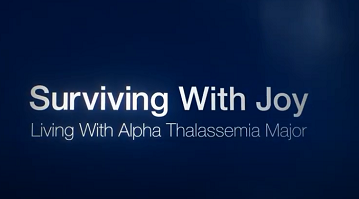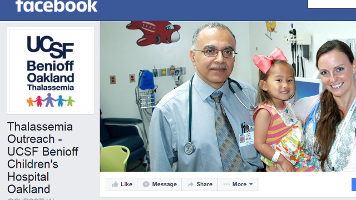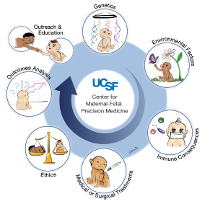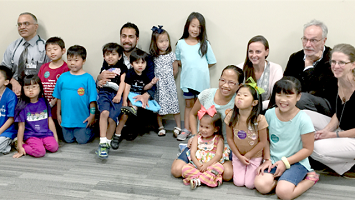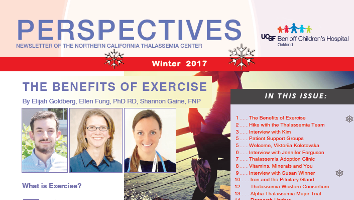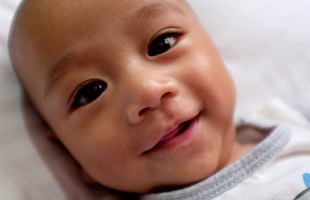Iron Measurement and SQUIDs Across the Globe
Marcela Weyhmiller, PhD
Director of the Iron Overload Program
December 2016
The sole purpose of the Iron Overload Program at UCSF Benioff Children’s Hospital Oakland is to quantify iron in the body. The cornerstone of this program is the SQUID-Ferritometer® or SQUID. SQUID stands for Superconducting QUantum Interference Device and is a very sensitive magnetic detector. Using a small magnetic field, the device is able to directly measure iron concentration in the liver, the primary location of iron in the body, by detecting its response to a changing magnetic field or magnetic susceptibility.
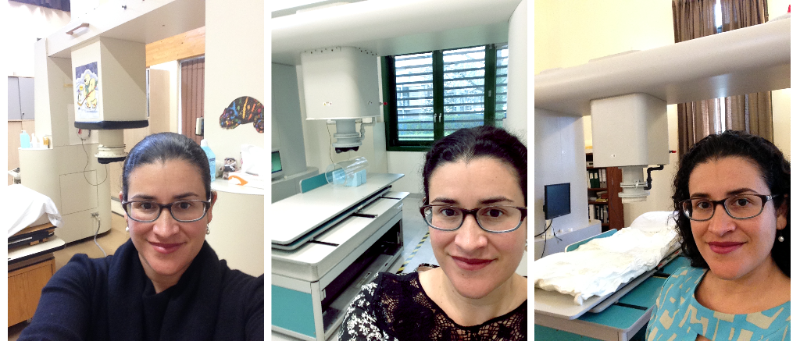
SQUID Selfies: Left to right: Marcela with the SQUID in Hamburg, Germany; SQUID in Torina, Italy; and back home with the Oakland SQUID
The procedure is pain-free, safe, and accurate. The special design of the machine allows for the measurement of iron in young children in as little as 10-15 minutes without the need for sedation. Since 2002, the SQUID has played a vital role in the management of a variety of diseases including hemochromatosis, myelodysplasia, sickle cell disease, thalassemia and other heavily transfused populations locally, nationally and internationally. Over 3000 measurements have been performed in Oakland alone with over ten-thousand performed globally. The SQUID is one of the original devices dedicated to non-invasive measurement of iron concentration, largely replacing the need to perform liver biopsies to measure liver iron concentration in our patients.
Over the years, the SQUID experience in Oakland has not changed much – the same familiar faces of the staff, having to wear blue paper shorts and cool ultrasound gel are still part of the measurement process. As Director of the Iron Overload Program, I have been busy working to develop a program with access to cutting edge techniques and helping to develop the next generation in iron measurement technology. In recent years we have been working closely with our radiologists and cardiologist to support the cardiac T2* measurements. Under the guidance of Dr. Roland Fischer, physicist and pioneer of body iron measurements, we are developing techniques to quantify iron in tissues such as the pancreas and bone marrow. With Dr. Ashutosh Lal, I have been working with three different groups to develop new susceptometry-based devices to measure iron which could be more affordable and accessible to patients across the globe.
I am always looking for ways in which we can improve our program here in Oakland. However, one of the challenges is that programs dedicated to measuring iron overload in the body are rare; and SQUID-based programs are even rarer. There are three dedicated SQUID programs in the world. This spring I had the privilege to visit our two sister programs in Hamburg, Germany and Torino, Italy where the other two SQUIDs are currently being used clinically. I was excited to meet the people who wrote classic papers on iron overload and with whom I communicated through email for several years. Above all I was excited to be surrounded by people who spoke my “language” and didn’t look at me curiously when I say that I “run the SQUID.”
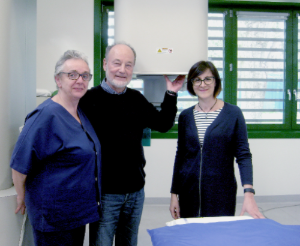 |
| Left to right: Silvana Audello, nurse and SQUID assistant (retired May 2016); Roland Fischer, PhD; Filomena Longo, MD, hematologist and director of the Iron Measurement Program at Torinoand consultant pediatrician |
My trip began in Hamburg to visit the University Medical Center Hamburg-Eppendorf (UKE) were I met up with Roland. Even though Roland is “retired” he coordinates a multidisciplinary Iron Group which consists of physicists, radiologist and pediatric hematologists who focus on the quantification of body iron. Our first stop was to visit Prof. Peter Nielsen (PhD, MD), who along with Roland, runs the SQUID at the Institute for Biochemistry and Molecular Cell Biology. The Hamburg SQUID has been in operation since 1989 and has the same basic design as the Oakland version with some significant differences. This program performs approximately 200 measurements per year, a similar number of patients each year to the program in Oakland. At the heart of their research program is a database which is similar to the one used in Oakland. We spent a typical day with their program focusing on just one family scheduled to have a SQUID and an MRI. Our MRI programs were quite different. The MRI suite was busy with four different MRIs and workstations filled with radiologist busy analyzing data. T2*s were performed by the radiologist of the multidisciplinary Iron Group.
From Germany we traveled to the Piemonte region in northern Italy. Roland and I spent the bulk of our trip with the group of Prof. Antonio Piga, one of Italy’s premiere experts in Thalassemia and also the person who introduced the SQUID Program in Italy. Their measurement program is large, performing more than 1,000 measurements on about 600 patients per year.
Torino’s SQUID is two years older than the Oakland SQUID with a strikingly similar design. Dr. Piga’s program recently moved to University Hospital San Luigi Gonzaga of Orbassano, where they were housed in a beautifully constructed custom built ferrous metal-free building. Their Iron Program is run by Dr. Filomena Longo, MD, consultant pediatrician, who is assisted by her nurse Silvana Audello (retired this past May).
I was amazed at the efficiency of this program to perform such a large volume of measurements. Around a half dozen patients pulled a number and waited for their turn. Silvana prepped patients, equipment and documents. She drew blood to measure ferritins and assisted Filomena with the SQUID. Filomena conducted the ultrasound, performed FibroScan (an ultrasound technique to assess liver fibrosis), SQUID and a chelation consult in about 20 minutes. In addition, she oversees the MRI measurements, analyzing the cardiac and liver MRIs. Due to the high throughput of patients, they no longer use their database and instead use a streamlined electronic medical record that they can use to do their research. Their MRI program is still growing, during my trip they were evaluating new software to help them analyze the liver and cardiac T2*s. In addition they are developing new SQUID techniques such as measuring liver iron concentration in pregnant women and neonates.
The majority of the patients in Torino have thalassemia hemochromatosis, hyperferritinemia and in some, sickle cell disease. However, with refugee migration the demographics of our European counterparts are changing with increases in number of patients with thalassemia syndromes and sickle cell anemia.
While the technology between all three sites is essentially the same the main differences between our programs are mainly logistical. The European SQUIDs have the European Union’s version of FDA. We are incorporating MRI technology into our programs in order to track iron concentration in non-hepatic tissues. The longevity of the staff was strikingly similar. For all three SQUID programs, a large percentage of the original staff is still working with retirement being the main reason people have moved on. I wonder what it is about this field that keeps the staff so dedicated. Is it that the more we understand the more questions there are to be answered? Is it the relationship we build with the patients and their families at yearly visits that feels familiar, like catching up with an old friend? Maybe it’s the sense of pioneering and owning the future of this niche field? Whatever it is, I feel drawn to it as well. As one of the newcomers to the field, I feel a sense of urgency to learn from these pioneers. As an engineer with a background in magnetic measurements, I feel prepared to work towards the future. We have our work cut out for us to continue to evolve our iron measurement programs in order to better serve our patients and to work to increase access of body iron measurement to patients across the globe.

